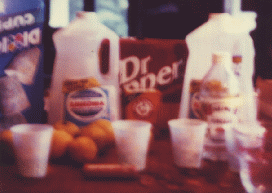


 |
|
Pictured above: Equipment used in this experiment, also pictured is Scientific AmeriKen's beverage of choice. |


| Substance added to pennies | Ph level | Observations |
| Lemon Juice | 2.3 | All five of the pennies were restored to their coppery color. |
| Vinegar | 3.0 | 3 of the 5 pennies were nearly restored to coppery color. |
| Baking Soda and Water | 9.0 | No effects were observable on the pennies. |
| Ammonia | 11.0 | Most pennies are partially cleaned, ammonia turned blue after process was complete. |

Back to the Scientific AmeriKen Homepage